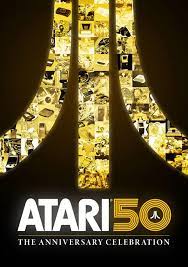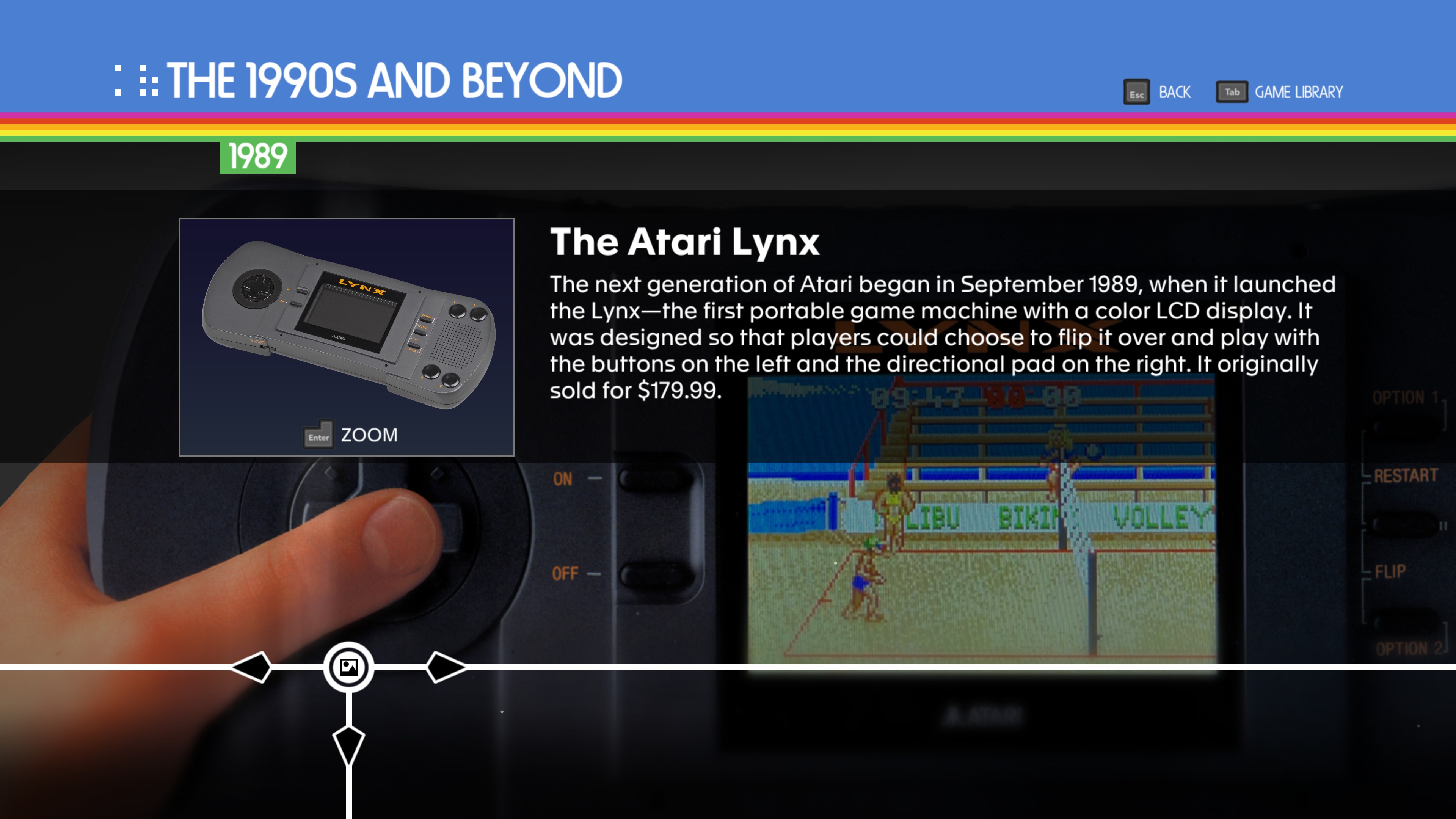Search
[{{{type}}}] {{{reason}}}
{{/data.error.root_cause}}{{{_source.title}}} {{#_source.showPrice}} {{{_source.displayPrice}}} {{/_source.showPrice}}
{{#_source.showLink}} {{/_source.showLink}} {{#_source.showDate}}{{{_source.displayDate}}}
{{/_source.showDate}}{{{_source.description}}}
{{#_source.additionalInfo}}{{#_source.additionalFields}} {{#title}} {{{label}}}: {{{title}}} {{/title}} {{/_source.additionalFields}}
{{/_source.additionalInfo}}- Details
- Category: Computer
- By Jason Gress
- Hits: 2211
Atari 50: The Anniversary Celebration (PC)

Atari 50: The Anniversary Celebration
Developed By: Digital Eclipse
Published By: Atari
Release Date: November 11, 2022
Available On: Atari VCS, PlayStation 4/5, Switch, Windows, Xbox One/Series
ESRB Rating: T for Teen for Blood, Drug Reference, Fantasy Violence, Language, Mild Sexual Themes
Genre: Arcade
Mode: One to Four Players
MSRP: $39.99
Thank you Atari for sending us this game collection to review!
Atari's been a part of my life since almost the beginning of it. I started playing video games at 3-4 years old, and my first game was played on the Atari VCS (later called the 2600). Mine was one of the early ones with the wooden front and sides, and looked really slick, with its metal toggle switches and classic matching controllers. So while it's hard not to argue that gaming got more advanced and arguably better in the decade that followed, there is no question that the first home console games ever were still a landmark in their own right. And I was fortunate enough to get to live through most (but not all) of it. (I'm not quite fifty years old yet - but Atari is!)
Atari 50: The Anniversary Celebration starts off with a very simple starting screen: you select where in Atari's history you wish to begin exploring. There are five eras: Arcade Origins, Birth of the Console, Highs and Lows, The Dawn of PCs, and The 1990s and Beyond. While they are in approximate chronological order, it's not exactly so; the PC era started before Highs and Lows, but is otherwise mostly in order. There is also a button you can press to go straight to the games if you wish.
I started from the beginning, Arcade Origins, and recommend you do so too. Rather than just being a bunch of Arcade games, this is a timeline starting from 1971 and the formation of Syzygy (which was renamed to Atari when there was a name collision) corporation, and their very first arcade game, Computer Space. While unfortunately that game is not playable, you do get to see high-quality pictures and a really neat video where a former Atari employee talks about his discovery in a newspaper ad about Computer Space machines for sale. It turns out that, after calling his old friends (and former Atari CEO), they confirmed that the very first one ever produced was in his collection.
Strong Points: Perhaps the most lovingly-crafted collection in history; timeline of Atari's history with video interviews, classic ads, concept art, quotes, and more interspersed with playable games; thoughtful and honest retrospective on the good and bad parts of Atari history; several excellent unreleased prototypes and homage remakes; covers the Arcade, Atari 2600, Atari Computers (400/800), 5200, 7800, Lynx, and the Atari Jaguar; spans a lot of genres including action, puzzle, dungeon crawlers, and more
Weak Points: It takes up 11GB of space, which is more than the more typical retro game collections
Moral Warnings: Game content varies widely, from shooting to fighters to dungeon crawlers with magic to zodiac signs; there are games with females wearing pixelated bikinis; some games feature blood; In the interview segments, there are references to drugs, a reference to game with a pedophile in it, some language like 'd*mn', 'h*ll', and 'sh*t'; one of the developers changed their name from a man's to a woman's name
Just one year later, Pong was released, and was the first successful arcade game. It sold thousands of units, and a fully-playable version is embedded right into the timeline so you can try it out right in context, next to videos about the birth of pong, as its creator shares his story, promotional flyers are also shared, and so on. They also share other historical oddities like the rare Pong Doubles and the especially rare Puppy Pong.
This same kind of treatment, throughout the nearly decade and a half that spans the Arcade era up until 1984 when they sold their Arcade division, is given to this timeline in the Arcade Origins section. We learn more about early hits like Breakout, more obscure releases like Sprint 8 and the handheld Touch Me. Of course huge releases like Asteroids and Missile Command are covered, and fully playable. The real standout was the Cosmos, an announced but never released holographic handheld game. I wish I got to play one of those!
After the Arcade Origins, this documentary experience dives into the Birth of the Console. The Atari VCS was the very first home video game console that played games stored on ROM (read-only memory) cartridges, which to this day still largely defines game consoles (even if Xbox and PlayStation never used cartridges, Nintendo still does). This section is packed with games and interesting trivia about them, though it only covers around a five-year span. Since they were the first, no one yet knew that a console's lifecycle was around five years yet! This of course leads to the next section...
Highs and Lows. This section covers most of the video game crash that started around 1982, and continues to cover Atari's good and bad throughout most of the 1980s. This was an interesting time of some good games, and some really bad ideas gone to market. The Atari 5200 was released, despite Atari's own engineers protests! How often do you see that happen? It also documents how the Atari 7800 was released way too late, with not enough new games to really make the new hardware shine.
Next, we have another bright spot in Atari's history - their home computer line. These proved to be extremely popular, especially the Atari 400/800 line. While I never owned one, I did have some very good friends who did, and they had great things to say about it. Considering the price of Apple's or IBM's PCs at that time, it makes complete sense that Atari would do so well in late 1979 and right in time for the 1980s. Computers were a brand new technology for everyone, and since Atari built it, it was ready to play games right away. Star Raiders is shown to be the first major game release, and having played it, I can see why it was so popular; it's an early space combat game with navigation, flight, and more. It sold well for a reason!
Other aspects of Atari's PC line are also documented, like classic TV commercials, the Atari 830 acoustic modem (you would attach it to your phone handset!) and other notable games and upgraded models. For example, the 800XL was Atari's best-selling computer model of all time, because it was inexpensive and more powerful than its older brothers. Near the end of the computer era, Atari tried to get into the IBM-Compatible PC market, and even released the first palmtop PC, which is what John Connor used to hack the ATM in Terminator 2: Judgment Day.
The final section of the Atari retrospective is the exploration of 1990s Atari. They made the decision to leave the PC market, and focus once again on video games. They released the amazingly powerful (and pretty!) Atari Lynx, which I was privileged enough to get to try in a mall stand when I was young. Considering the main competition was the four shades of green Game Boy, it was quite amazing! It was expensive and didn't have a very large library, which is unfortunate, but it's really neat that not only do we get to learn more about this, but we get to play some of the games!
Just a few years later, we get to experience Atari's final cartridge-based dedicated game console, the Atari Jaguar. As a huge gamer myself of that era, they had some incredible marketing, promising the first 64-bit gaming system. It wasn't actually 64-bit, but rather dual 32-bit. But even still, the system was quite powerful for its time, and had some rather unique games on it. The pack-in game Cybermorph was about as cutting edge as it got in 1993, with a polygonal 3D shooter with smooth animations that smoked Nintendo's Star Fox, released around the same time. The collection shares several other factoids about the Jaguar, along with more games, before touching on Atari's resurgence once again in the 2020s, with their new Atari VCS mini PC, and their great Recharged titles that I've had the pleasure of reviewing. They also touch on Atari 2600 homebrew, and conclude with discussion about Ready Player One and a final look back at the last fifty years.

Higher is better
(10/10 is perfect)
Game Score - 94%
Gameplay - 19/20
Graphics - 9/10
Sound - 9/10
Stability - 5/5
Controls - 5/5
Morality Score - 68%
Violence - 6/10
Language - 6/10
Sexual Content - 6/10
Occult/Supernatural - 6/10
Cultural/Moral/Ethical - 10/10
The presentation of this Celebration of all things Atari is full of clean, colorful lines and animations everywhere bringing life and context to these otherwise boring menus. Everything about the way the timelines are presented is really well done, and quite inviting to the eye. The only thing I wish was more prominently displayed was access to the game library; it can be accessed with the press of a button, which is noted at the top of the screen, but your eyes might not be drawn to it at first.
It's worth pointing out that with a collection of over one-hundred games, appropriateness issues are going to be all over the place. Most games have shooting of some kind, but not all. Some have punching & kicking. A small number have blood. Another might have women in a bikini (though very low resolution). Some also have magic, zodiac symbols, and horror elements like skeletons and ghosts. Again, the vast majority is low resolution, but it's worth pointing out.
Also, the documentary videos themselves describe what really happened, and it's not always good. A few curse words slip into there, like 'd*mn', 'h*ll', and 'sh*t'. One video talks about a game where there is a pedophile in it, and another video talks about the rampant illegal drug use in the early days of Atari. I found one small detail confusing; a game was credited to a woman's name, but after searching for more information on this person, they were a man when working at Atari.
Atari 50: The Anniversary Celebration is quite possibly the greatest gaming retrospective of all time. I cannot imagine a more honest or comprehensive documentary coverage of one of the most important companies in the history of video games. It also doesn't pull punches - it accurately points out flaws, even when they hurt; for example, when Atari didn't pay their employees enough to make their games, several left and founded the first 3rd-party console game developer ever, Activision. Being brought along for an expert retelling of the history of the once great Atari, and being able to play along with it all is just fantastic. It also helps that Digital Eclipse went the extra mile and reimagined several classics, and even completed the Swordquest quadrilogy that never had its last game. The reimagined title VCTR-SCTR is a huge standout that any fan of classic vector games will enjoy.
If you love classic Atari games, or even have a passing interest, then you owe it to yourself to check out the Atari 50: The Anniversary Celebration. I've never seen a more lovingly crafted collection than this, and I'm sure that care will come through to you, too. The only downside? All of those videos take up space - around 11GB worth! A 'pure' game collection without all of that commentary would likely be a fraction of the size - but also a fraction of the charm.








